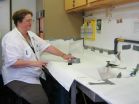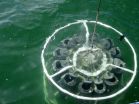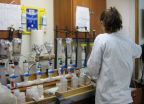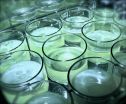The multi-partner project was funded by the National Oceanic and Atmospheric Administration's ECOHAB program* (described below) and included 14 research papers from seven institutions.
The research team studied four red tide blooms caused by the harmful algae species Karenia brevis in 2001, '07, '08 and '09, plus the non-bloom year 2010. Their goal was to understand which nutrients supported these red tides and the extent to which coastal pollution might contribute, helping reveal what drives red tide in southwest Florida.
Study partners documented 12 sources of nutrients in southwest Florida waters -- including some never before associated with K. brevis. Results supported the consensus that blooms start 10-40 miles offshore, away from the direct influence of land-based nutrient pollution, but once moved inshore blooms can use both human-contributed and natural nutrients for growth.
The project documented the microbiology, physiology, ecology and physical oceanography factors affecting red tides in new detail, provided a synthesis of results and offered suggestions for resource managers addressing red tide in the coastal waters of southwest Florida. Florida red tide blooms -- which occur naturally in the Gulf of Mexico and most frequently off southwest Florida -- are higher-than-normal concentrations of the microscopic algae species K. brevis, a plant-like organism whose toxins can kill fish and other marine species, make shellfish toxic to eat and cause respiratory irritation in humans. These blooms occurred centuries before the mid-to-late twentieth century population boom along Florida's coast. Now, with large numbers of coastal residents and visitors in Florida, blooms can significantly affect public health and the economy.
Public information and short-term forecasts help mitigate red tide impacts, but ongoing research is critical to inform resource managers working to understand and potentially reduce nutrients available to blooms.
"Data go a long way toward increasing our understanding," said Dr. Cynthia Heil, Senior Research Scientist at Bigelow Laboratory for Ocean Sciences in Maine, who co-edited the special issue of Harmful Algae and was formerly with FWC's Fish and Wildlife Research Institute. "This report, which includes data from four different red tides and numerous laboratory studies and modeling efforts by biological, chemical and physical oceanographers, shows the collaborative efforts needed to understand why Florida red tides are so frequent and harmful in this region."
Co-editor Dr. Judith O'Neil, Research Associate Professor at the University of Maryland Center for Environmental Science, added, "We learned that K. brevis is an adaptable and flexible organism. We identified 12 different sources of nutrients that it can take up and use. One of the most interesting things that hadn't previously been taken into account is this organism's ability to not just use sunlight, like plants, but to also consume other single-celled organisms as a nutrient source. Additionally, its migratory behavior and directed swimming allows K. brevis access to nutrient sources everywhere it finds them -- at the surface, bottom and throughout the water column."
According to the study, K. brevis can get the nutrients nitrogen and/or phosphorus from the following sources (bold sources were newly linked to K. brevis blooms through the ECOHAB project): Undersea sediments Decaying fish Water flowing out of estuaries Deposits from the atmosphere Nitrogen from the air transformed, or "fixed," into a more useable form by the naturally occurring bacteria Trichodesmium. (They are a type of cyanobacteria, which use energy from sun to make food, like plants. They can multiply and form blooms.) Waste from zooplankton -- small aquatic animals visible to the naked eye The "grazing" of smaller zooplankton, dubbed "microzooplankton" because they can only be seen under a microscope. (Grazing includes their "sloppy eating" of other tiny life forms, along with the their waste.) Picoplankton -- tiny life forms that K. brevis consumes Bacteria transforming nitrogen in the water into more useful forms Light creating available nutrients from natural, dissolved compounds like tannins in the water Decay of Trichodesmium blooms (newly documented as a long-term nutrient source for K. brevis blooms) Nitrogen from the air "fixed" by other cyanobacteria that are NOT Trichodesmium
The researchers concluded that many of these nutrient sources are individually more than enough to support observed blooms, but no single nutrient source is solely responsible.
Naturally occurring Trichodesmium (defined above) provided the most nitrogen, but not all, for K. brevis blooms developing offshore. Nearer to shore and within estuaries, major nitrogen sources believed to support blooms included estuary water carrying land-based nutrients to sea, underwater sediments and dead fish decomposing, in addition to other sources.
A few coastal sources -- estuary water, deposits from the atmosphere and underwater sediments -- are known to carry natural nutrients as well as some enhanced levels due to human activity. With other nutrient sources -- such as microscopic life forms -- connections with human activities are less direct, so it is harder to predict how they might be influencing red tides.
"Nature is messy, but this project has put several new pieces in place," said Dr. Kellie Dixon, Senior Scientist at Mote Marine Laboratory and Co-Principal Investigator for the ECOHAB project. "Until now we had not looked at this many of the 12 sources and their specific quantities simultaneously. Some of the sources, like nutrients released from the sediments, had never been measured in southwest Florida's coastal waters until we studied them for ECOHAB."
The project blended nutrient studies with physical oceanography, shedding new light on how blooms are brought to shore.
"Until now, effective management of harmful algal blooms caused by K. brevis was complicated because we didn't know enough about how different nutrient sources and forms taken up by K. brevis interacted with the physical environment," said Matt Garrett of the Fish and Wildlife Research Institute, who managed the ECOHAB project. "This project provides data that can help inform management recommendations on how to control nutrient sources and possibly improve forecasting models."
The special issue of Harmful Algae includes the following management recommendations: Maximize efforts to reduce potentially controllable nutrient inputs and sources that contribute to K. brevis blooms. Monitor for known physical conditions that favor/disfavor the initiation, transport and export of K. brevis blooms in the southwest Florida region. Identify and provide necessary funding at state and federal levels to maintain the southwest Florida coastal observing system infrastructure on an operational basis.
INFORMATION:
See abstracts for all the papers at: http://www.sciencedirect.com/science/journal/15689883/38
For full text of individual papers, please ask the media contacts listed above.
This research was funded by NOAA's NCCOS Ecology and Oceanography of Harmful Algal Blooms Program (ECOHAB): Karenia program -- a five-year collaborative research project funded by NOAA's Coastal Ocean Program. The effort was led by the FWC's Fish and Wildlife Research Institute in St. Petersburg, Fla., and involved Co-Principal Investigators from the College of William and Mary's Virginia Institute of Marine Science (VIMS); Mote Marine Laboratory; University of Miami; Old Dominion University; University of Maryland Center for Environmental Science; Horn Point Laboratory; and the University of South Florida.






